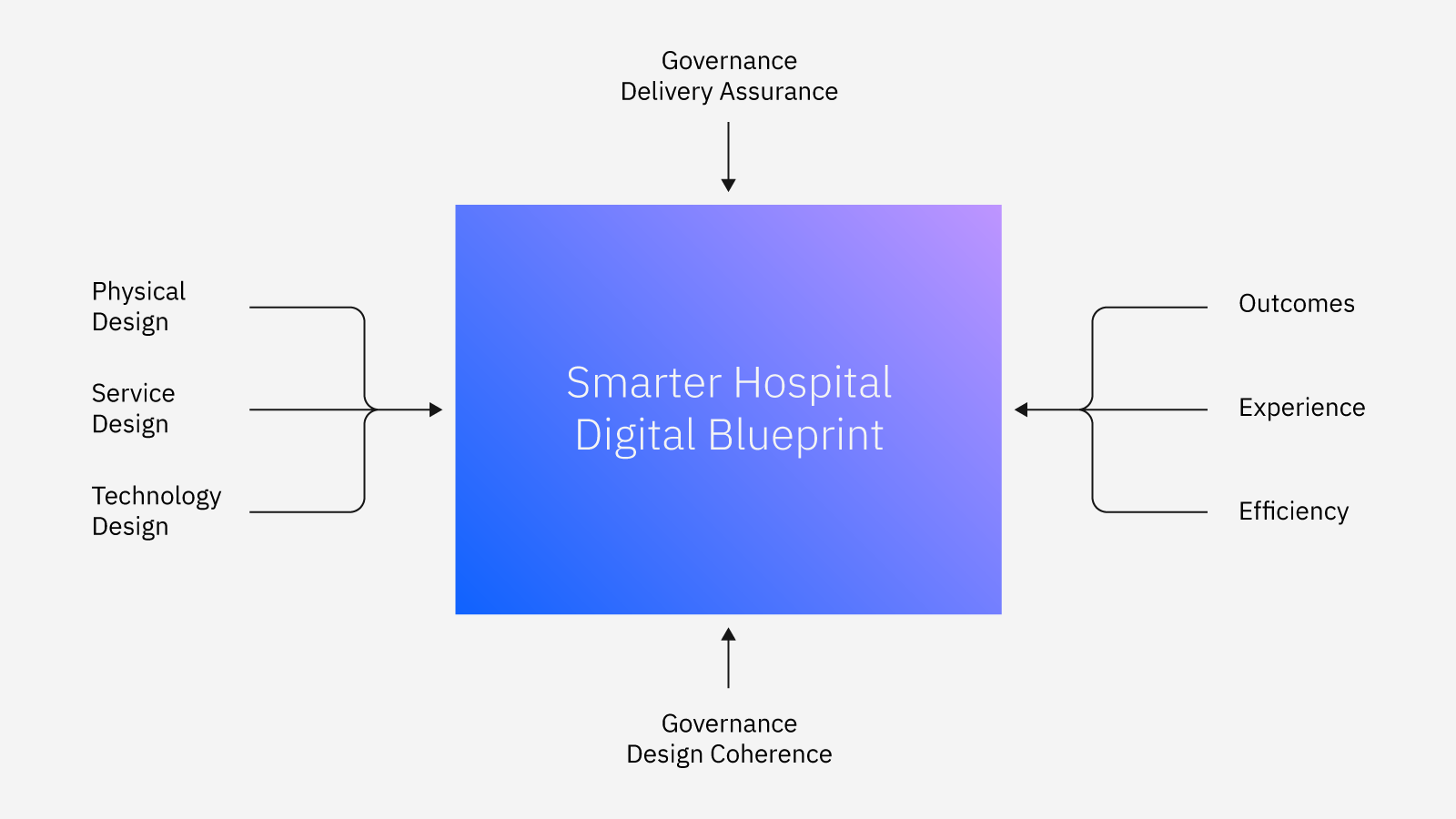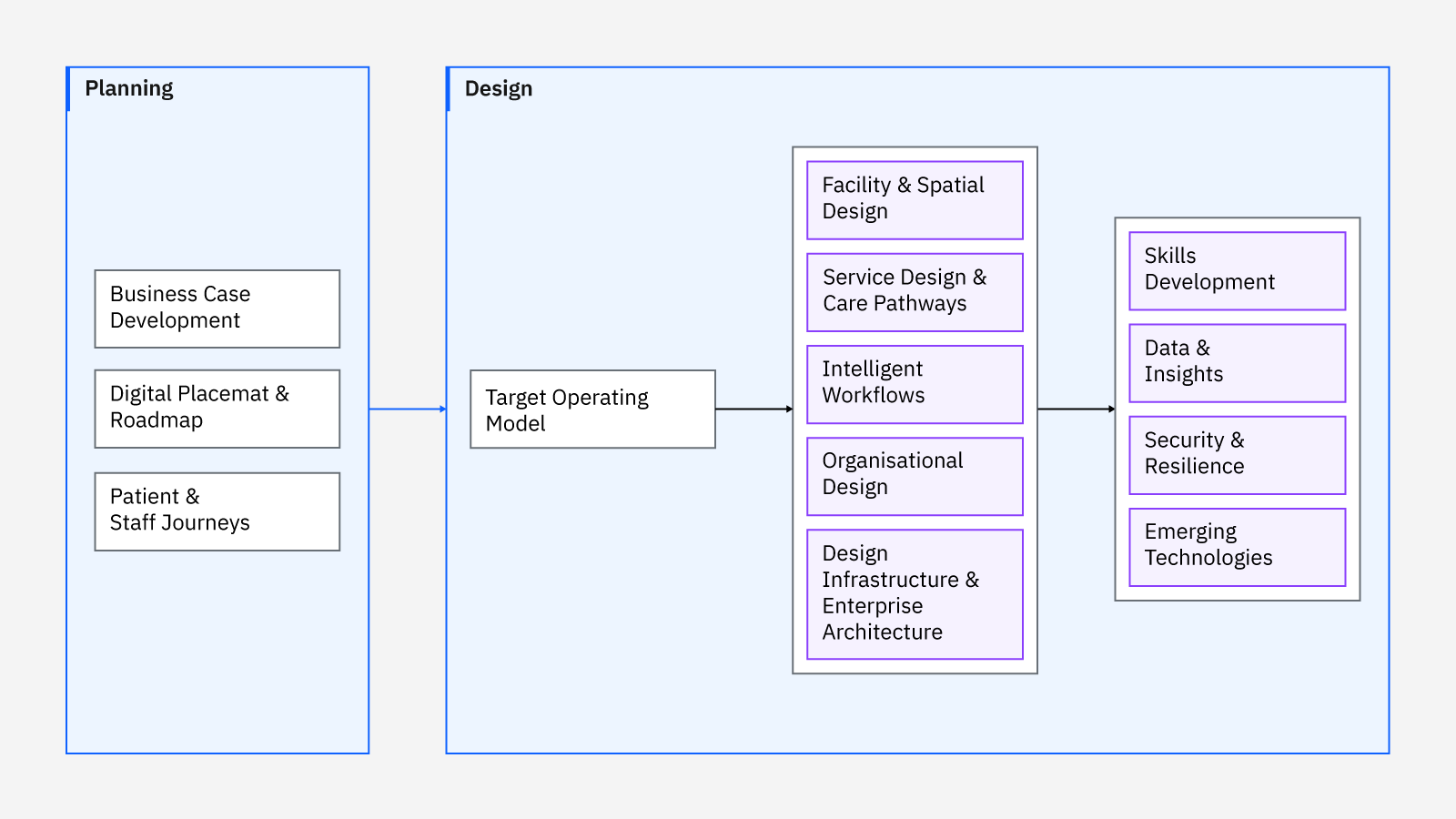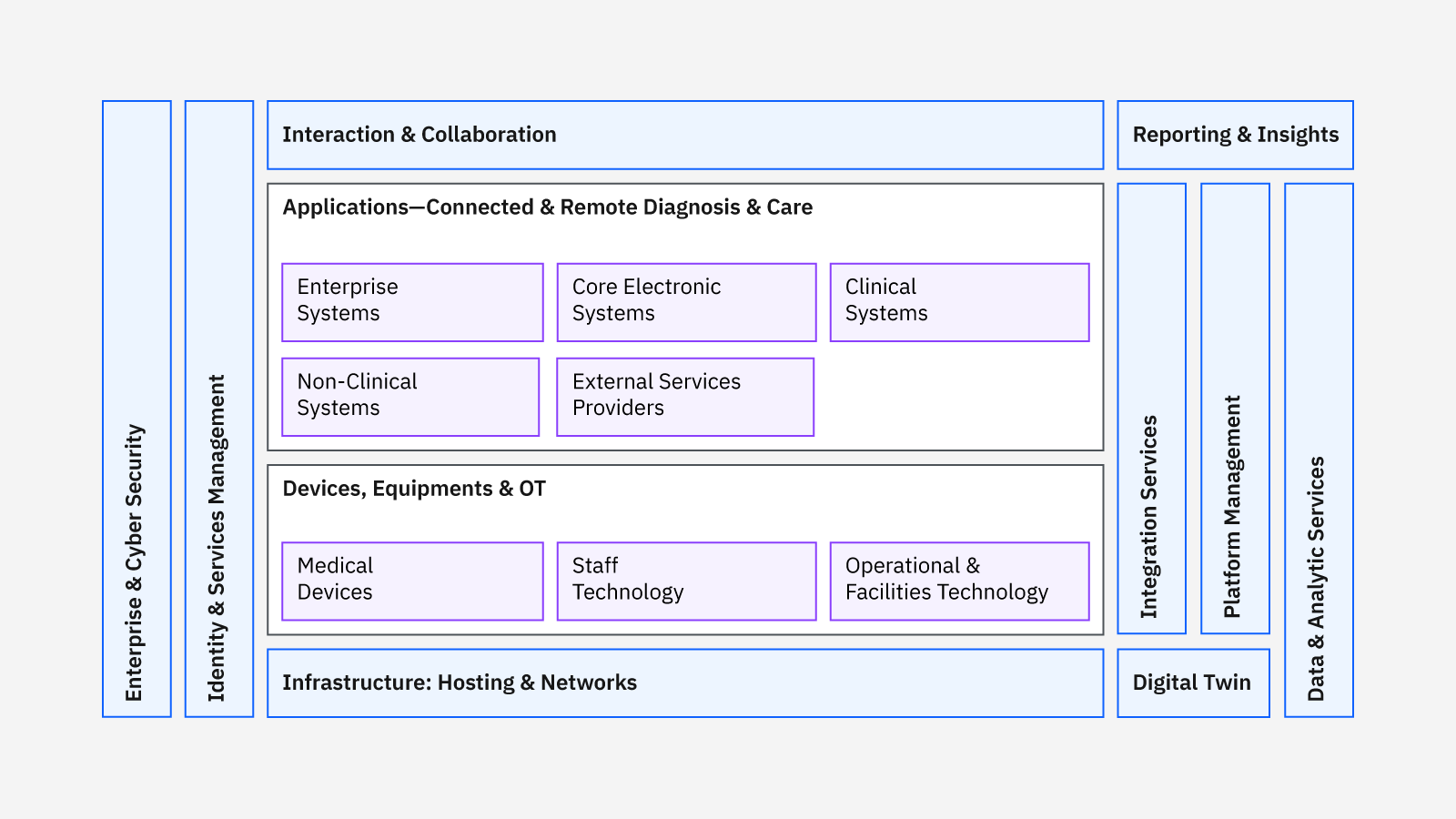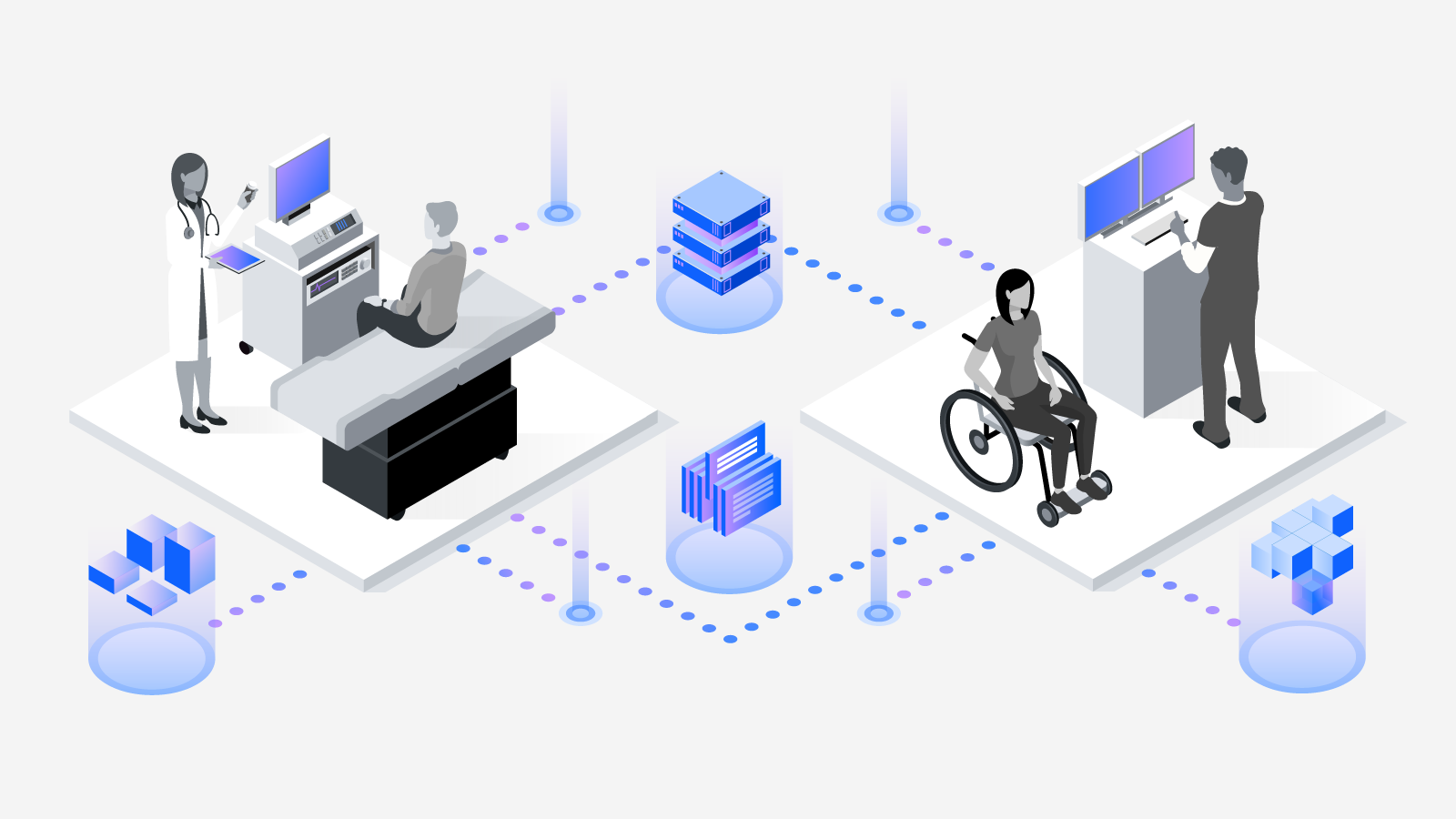
A Blueprint for Smarter Hospital Design
Delivering care differently
4 min read
An opportunity to delivery care differently
The government’s initial investment of £3.7 billon to support the New Hospitals Programme presents a unique opportunity to redefine, refresh, and optimise the way that care is delivered and improve collaboration between previously siloed care providers. A more integrated approach to the design of our hospitals combined with the increased exploitation of digital technologies presents genuine opportunity to enhance user experience and deliver previously untapped benefits, by building facilities that are designed around the staff and patients that use them.
For those planning the delivery of smarter, more digitally enabled hospitals, the challenge is vast. COVID-19 has compounded pressures already faced by a healthcare service coping with burgeoning waiting lists and unprecedented estate maintenance backlogs.1 NHS trusts have an imperative to act, yet must balance short-term, “business as unusual”, pressures with the longer term demands to plan and phase new hospital investments that will deliver on the vision of a better, more effective model of care.
This next wave of new, digitally enabled hospitals presents a real opportunity to focus design on the needs of the users to deliver the “smart foundations.”2 It will provide the stimulus to deliver care differently and increase the exploitation of digital innovation to enable new, more effective, more integrated models of care. Additionally, it will provide the catalyst to accelerate progression towards net zero carbon and develop hospitals that are “reliable, modern secure, sustainable and resilient” by design.

The Smarter Hospital concept
IBM has traditionally framed “smarter” as capabilities that benefit from being instrumented, interconnected and intelligent.3 The concept of a smarter hospital focuses not just on the building but its role within an integrated care system and, particularly, in joining up care pathways at place level. The smarter hospital focuses on the lives of its people—those working in it, receiving care or visiting—the processes that run within the organisation, and its impact on the community and the environment in which it operates.
IBM’s Chief Medical Officer Mark Davies helped further contextualise this concept in proposing a vision for smarter hospitals based around a human-centred, digitally enabled hospital, harnessing existing and emerging technology to improve the experience and efficiency of patient pathways and clinician workflows as set out below.4
Setting a vision: Smarter Hospital goals
Smarter hospitals combine the benefits offered by an improved and more sustainable physical environment with advances in digital solutions and technologies, and the development of new operating models to take pressure off the existing workforce and deliver on the following key transformation goals:
- Experience that places patients and staff at the centre of effective Smarter Hospital design
- Efficiency in the design, through-flow and operation of the new facilities and the technology that supports it
- A workplace designed to support the digital enablement of clinical and operational processes, capable of driving real improvement in outcomes—for patients, for clinicians and for those responsible for the smooth and efficient operation of the hospital
Charting the way
3 min read
The only way to design a successful hospital is to put people’s needs at the centre.
Hospitals built today need to endure for many decades and adapt to significant societal, cultural, environmental and technology changes during their lifetime. The only way to design a successful hospital is to put people’s needs at the centre, through user-centred design and ensure the capability to change is factored in from the outset.
For those charting their journeys to implement the new breed of smarter hospitals—confidence is key. The adoption of a trusted delivery framework and repeatable model that reflects the learnings that others have made can offer real value for those contemplating how to transform their vision into a viable programme. These frameworks can guide and accelerate the redesign of care models to develop the new and improved user journeys that will address known pain points and deliver on targeted improvements in experience and efficiency.
This smart paper presents a proven and repeatable model to deliver on the smarter hospital vision and offers practical advice and guidance to those contemplating such journeys through the lens of our smarter hospital digital blueprint.
The Government Office for Science and the Council for Science and Technology encourages the application of technology to “transform the health system and create a more personcentred service. ”
IBM’s vision
Our vision for the smarter hospital is founded on three simple constructs:
Experience has shown that there is enormous value in setting out “the how” upfront. Here our smarter hospital digital blueprint reflects our experiences in translating vision into action, in charting the transformational journey into manageable steps, and in aligning often disparate groups of stakeholders behind a common vision and delivery framework.

The IBM Smarter Hospital Digital Blueprint
3 min read
Trusts need to consider their own unique mix of challenges as they consider the framework for a smarter, more digitally enabled future.
As trusts contemplate their journeys towards a smarter, more digitally enabled future, differences in population health metrics, geographical location, clinical specialisms, and physical footprint mean that each trust will face its own unique blend of challenges, constraints and targeted benefits. And each trust will need to chart its own journey to reflect trust priorities, timelines and funding.
We have translated our experience supporting the delivery of smarter hospitals and combined them with our experience in digital transformation across private and public sectors into a smarter hospital digital blueprint. A repeatable toolkit that can encourage a holistic approach to planning, design and implementation and provide both the “North Star” and structure to support your transformation.
Our aim is to establish a practical guide that can be used by trusts from the outset of their new hospital programmes. It’s a vehicle that helps develop the digital maturity of the trust, a framework through which to understand where and how innovation and emerging technologies can make a real difference. And it serves as the foundation to provide practical support through the detailed design and implementation phases.
The blueprint comprises two sets of blueprinting activities and associated artifacts:
Planning includes a suite of 3 enabling blueprint components and activities aligned to:
- Business case development—articulating the strategic, economic, commercial, financial and technical cases
- Patient and staff journey design—user centred design to deliver on the vision for Smarter Hospitals
- Digital placemat and roadmap—to define the new, supporting technologies and to phase their implementation

At the end of the planning phase, the blueprint will reflect the prevailing digital maturity and define the gap between the prevailing digital footprint and what’s needed to deliver on the future vision for a smarter hospital. It will break down and assess the investment needed in digital to underpin business case preparation and set out the steps needed to be developed during the design phase.
Design—A suite of 10 foundational components, including articulation and documentation of:
To describe the to-be delivery model for the smarter hospital, articulated in terms of clinical process, operational process, organisation, technology, people and place
To set out the physical layout, fabric, footprint and flow of the new facility and alignment to key sustainability goals
To develop and document the to-be staff and patient journeys, to define how the hospital operates within a future integrated care model
To define how the new physical design and digital solutions will be “e-enabled” to reduce waste and improve efficiency and experience
To set out the organisational model needed to support the redesigned hospital based on what services and functions the hospital will self-deliver, manage and buy in
To develop and document the digital architecture to support and sustain the exploitation of digital capability
To set out how the hospital plans to optimise the benefit presented by automation, virtual and augmented reality, virtual assistants, 5G, the Internet of Things (IoT), blockchain and other emerging and evolving technologies to relieve pressure on the existing workforce
To set out the data strategy, governance and design principles to underpin the better capture, sharing and use of data to drive better and more timely decision-making
To develop and document the processes, procedures and mechanisms to better manage and protect exposure to external threats and cyberattack
To evaluate and define training and educational activities needed to support the various hospital stakeholder communities in a more connected and digital world
Together, the components of the smarter hospital digital blueprint provide a set of artifacts that frame and define a smarter digital hospital, providing the vehicle through which to realise the benefits offered by the investment in smarter hospitals.
A templated approach to the assessment of a trust’s digital placemat can be accelerated and assured through comparison with IBM’s smarter hospital digital reference architecture.
The IBM Smarter Hospital Digital Reference Model
3 min read
A templated model for the development of a future-fit digital placemat and supporting roadmap.
IBM sees excellence in digital design as a key tenet in assuring the delivery of smarter hospitals. In support of this vision, we’ve developed an IBM smarter hospital reference model that comprises 11 key digital dimensions and 111 digital capabilities. This architecture reflects the lessons we’ve learned supporting clients in healthcare and beyond with their successful digital transformations. It has been developed to support coherence and efficiency in physical design—the layout, operation and flow of the hospital—and to support excellence in service design.

This reference model has been informed by our knowledge of what patients want, and what trusts and care providers need to better deliver their services. It’s underpinned by the possibilities offered by emerging and evolving digital technologies, which will enable the iterative and continuous improvement of the services offered to patients. This model will enable your hospital to be fit for the future, as new service requirements emerge.

Blueprint in action
Conclusion
3 min read
How IBM can help
As we emerge from COVID-19, NHS trusts are at an inflection point and faced with the burden of coping with increasing demand alongside existing infrastructure. The investment in the New Hospitals Programme presents a real opportunity to accelerate the pace of transformation and can be a catalyst to drive towards the realisation of potential benefits in terms of efficiency, experience and better outcomes for all.

As trusts tackle the start-up of their New Hospitals Programmes, planning and integrated design, there’s clear merit in learning from the experiences of those who have gone before, and in the adoption of more repeatable, more templated models of delivery. The IBM smarter hospital digital blueprint provides a proven model to support and accelerate your smarter hospital journey—bringing together the strands of service, technology and physical building design into a cohesive delivery framework.
IBM delivers business transformation, technology and digital design services. We draw from a rich portfolio of successful digital transformation experiences across healthcare and more broadly. We bring together teams that combine deep healthcare expertise with an understanding of digital, physical and service design. We also support you in the application of our smarter hospital digital blueprint, which brings structure, confidence and assurance to all those involved in the planning and design of smarter hospitals.
For more information on our Digital Blueprint and associated Healthcare Services please reach out to the team.